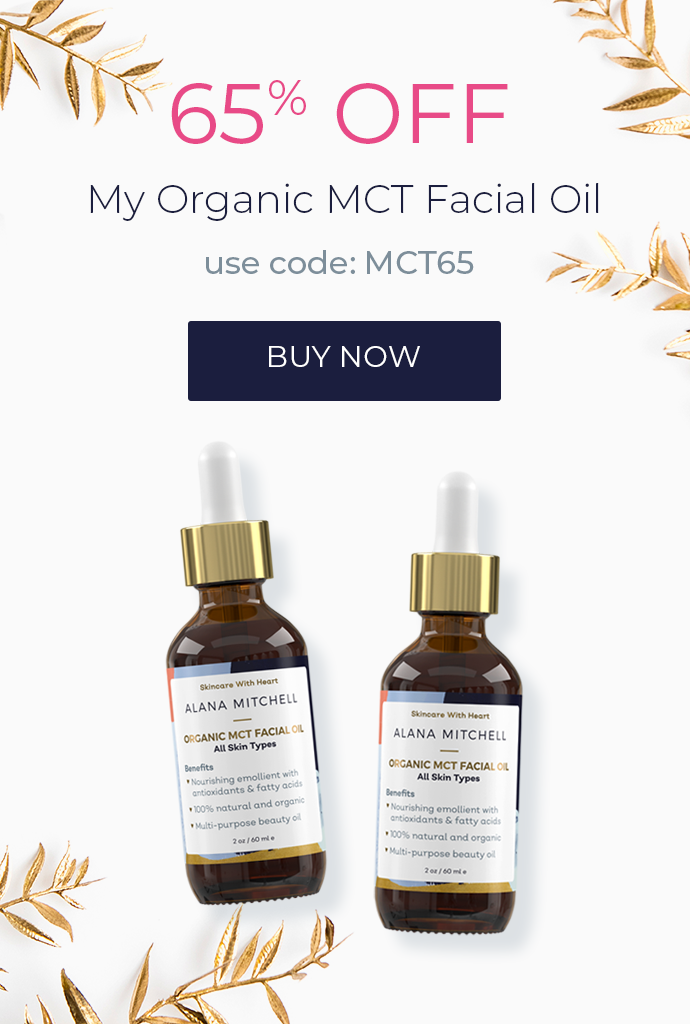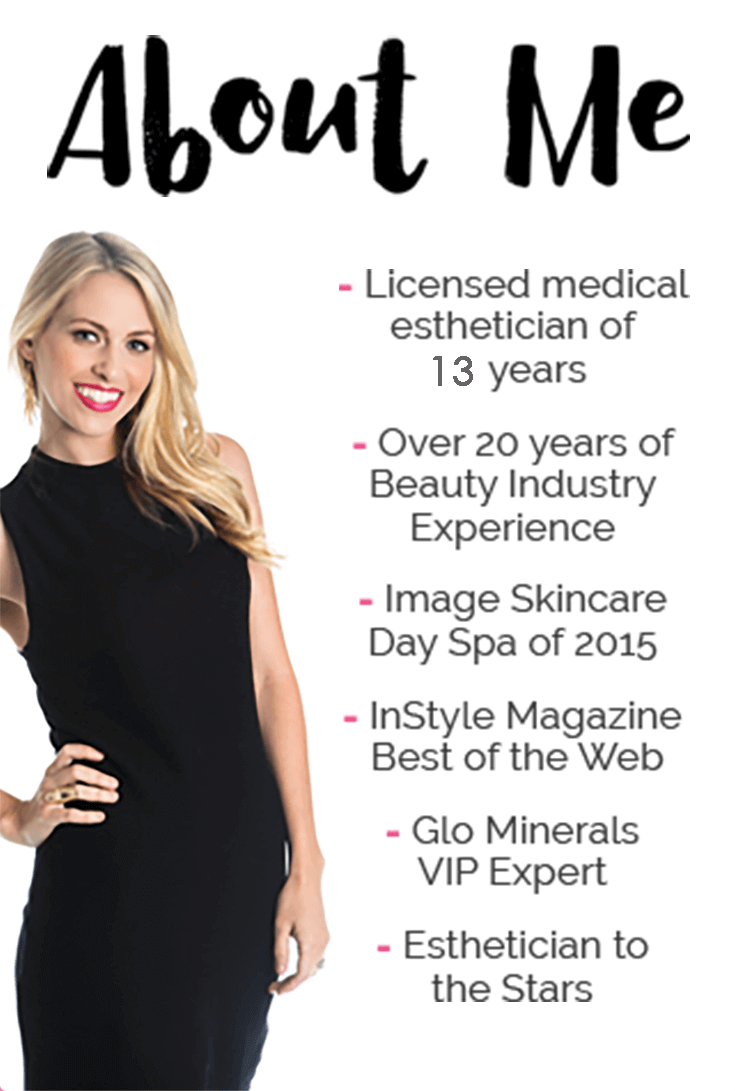What Should You Be Using In Your Skin Care Routine?
Take my quiz and get personalized recommendations from a
licensed esthetician!
Chapter 7: Skin Types

We all want great-looking skin, but buying fancy products or undergoing high-tech cosmetic procedures isn’t going to do much if you don’t know what your skin needs.
After all, one size does not fit all when it comes to skincare.
To find out what your skin is craving, you need to find out your skin type.
Think of your skin type as your road map to how to take care of your beautiful skin.

Keep in mind that within these five skin types, there is a ton of variety.
Plus, sensitive skin can be in combination with any of the skin types.
Your skin might be dry, but not dry enough to actually be flaky or rough.
You may also go through certain periods where your skin type changes based on your hormones, your health, the weather, or even simply what products you’re using.
While normal skin is probably what we’d all love to have, there is no “best” skin type, and all skin types have the potential for acne or skin conditions.
There are benefits and downsides to each skin type.
Those with oily skin may be more prone to acne, but those with dry skin may see earlier signs of aging.
There’s no use in trying to “change” your skin type, but skincare is all about making our skin as normal as it can be!
And for most of us, that means restoring our skin to equilibrium (or as close as possible to equilibrium).

How To Determine Your Skin Type
If you’ve gotten this far in your life without noticing your skin type, there’s a chance you may just have normal skin!
But, let’s double check to make sure!
An easy-peasy skin type test is what I like to call “the tissue test.”
Essentially, you run a tissue across your skin (be sure to apply some pressure) and look at the tissue.
If you see dampness or oil on the tissue, you probably have oily skin.
If you see skin flakes (or nothing at all) on the tissue, and your skin feels tight, you probably have dry skin.
If you find that certain parts of your skin leave oil spots, but others do not, you probably have combination skin.
Lastly, if the tissue is clean and you don’t feel any irritation, you probably have normal skin—lucky you!
If you have sensitive skin, you probably already know this from certain reactions you’ve had in the past.
Generally, those with sensitive skin skew more towards the dry skin type.
Another simple way to determine your skin type is to simply sit and wait.
Step 1: Wash your face
Wash your face the way you normally would, and be sure to remove your makeup as well!
Step 2: Wait 2 hours
Instead of going through your evening skincare routine, let your face dry after washing it and go bare.
Que up Netflix, read a book, or get some work done—just don’t put anything on your face!
Step 3: Observe
Does your face feel dry and tight without your daily moisturizer? Does it look dewy and glowy?
Take notes of how your face looks and feels and compare it to the five types I listed above!
It’s amazing how different your skin can feel without your usual products, isn’t it?

How To Care For Each Skin Type
Now that you’ve learned what kind of skin you have, it’s time to learn the basics of how to care for your skin!
Normal Skin
Lucky for you, normal skin means you likely won’t have to deal with some of the pesky skin “problems” your friends may gripe about.
However, normal skin doesn’t mean your immune to sun damage, aging, or “dull” skin—and everyone’s skin could use some moisture!
Don’t take your good skin for granted—take care of it so that it continues being normal!
I always recommend wearing a lightweight daily moisturizer with SPF.
You should also find a cleanser that works for you, as well as a makeup removal method.
Of course, you can pick and choose products as you see fit (assuming they don’t mess with your skin’s equilibrium), but I also always recommend an eye cream.
If you’re going to use one anti-aging product, an eye cream is sort of like the holy grail!
Just use your ring fingers to dab that cream one nightly before you get your beauty rest.
Product recommendation for normal skin: Alana Mitchell Foaming Pumpkin Cleanser
Dry Skin
If you have dry skin, or if you live somewhere dry—moisturizer is going to be your BFF!
While many people make the mistake of thinking too much moisture can lead to acne, too much dryness can lead to acne as well!
I have way too many friends who actually started breaking out once they moved out to California because their skin wasn’t used to the dry climate!
Once they started moisturizing multiple times a day, their skin improved!
In addition to moisturizer, you may also want to load up on hydrating masks, facial sprays, and more.
Last but not least, keep your eyes peeled for any ingredients that may make your skin dry.
While salicylic acid is used in many anti-acne products, it also will dry out your face.
So, if you are trying to fight breakouts, try to balance out your anti-acne products with moisture—and apply the product sparingly and only to problem areas!
Product recommendation for dry skin: Alana Mitchell Daily Vitamin C Moisturizer
Oily Skin
My best advice for ladies with oily skin?
Embrace that natural glow, girl!
Some of us have to apply highlighter to get what you’ve got going on naturally!
In all seriousness, oily skin may make you feel prone to breakouts or a lil’ extra shiny at times, but there are products to help you out.
I love those little oil-blotting wipes to throw in my purse for oily days, they’re perfect before a photo op.
And while it might seem counterintuitive, oily products can actually be great for those of us with oily skin!
Trying to “dry” your skin out by devoiding it of products will actually just cause your skin to make more oil.
It’s sort of like how your body holds onto weight if you stop eating.
Exfoliating your skin is a great way to control the oil production and make your pores appear smaller.
And, repeating some of what we went over in chapter 1 — eating less oily foods can help your skin tone down the oil as well.
Product recommendation for oily skin: Alana Mitchell Brightening & Exfoliating Anti-Aging Masque
Combination Skin
Yep, you guessed it!
To care for combination skin, you’ll want to incorporate a combination of the tips I included for dry and oily skin.
Once you recognize which areas of your skin are more prone to oil (likely your t-zone), you can apply certain products to certain areas of your skin.
For example, you may want to add some extra moisturizer to your cheeks, but only use one layer on your chin and forehead.
Another great product for combination skin are masks.
You can use a pulling mask on the oily parts of your skin, and apply a moisturizing mask to the drier areas.
You may end up looking like a work of art after blending all those masks together!
Product recommendation for combination skin: Alana Mitchell Night R1 Retinol Facial Oil
Sensitive Skin
If you have sensitive skin, you want to take extra precautions when purchasing new products—or even trying samples of products.
I recommend avoiding any products with added fragrance, as those tend to cause reactions in those of us with sensitive skin.
Other tips I have are to bring a little bit of Benadryl in your purse wherever you go!
Better to be safe than to face a red splotchy face while out to dinner with friends, that’s what I always say!
If you constantly struggle with redness, itchiness, or other reactions, I recommend stripping down your skincare routine to just water.
It sounds crazy, but I know women who swear by it.
Think of it as doing an elimination diet for your face.
Once your skin (hopefully) normalizes a bit, you can start adding products back in.
That way, you’ll see what was exacerbating your skin.
And, of course, if you see a product that has a specific version designed for those with sensitive skin—always choose that option!
Product recommendation for sensitive skin: Alana Mitchell Hyaluronic Moisture Boost Serum
Final Thoughts
It’s truly amazing how much improvement you may see in your skin once you start working on building your own skincare routine made for you and your skin type.
Of course, there’s still a ton of trial and error to be done, but that’s what I’m here to help you with!
When combined with some of the other basics in this series (think healthy eating), your skin will be bright and beautiful before you know it—regardless of what type of skin you have.
In the comments below, feel free to share your skin type and your favorite products!
1 comments
There are a number of skin care treatments available today, which help individuals rejuvenate their skin to a great extent. Skin problems and aging have become quite common because of the hectic lifestyles we lead, genes and other environmental conditions. A number of different types of treatments are now available which help solve problems like wrinkles, acnes, fine lines and other skin diseases.
Quite a few skin treatments are also available to manage chronic skin conditions like eczema, psoriasis and rosacea. Although chronic skin problems are not quite curable, their signs and symptoms can be effectively dealt with through various skin treatments.
it is important for a person to follow a doctor’s instructions on how to treat skin problems and always buy prescribed meds only. There are too many online stores offering meds online like amazon, healthkart, and mygenericpharmacy etc which are most popular.





















